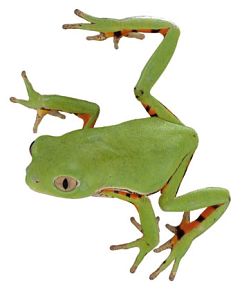 EDUARDO CESARA green frog with black and orange stripes on the sides of its body produces a cutaneous secretion that keeps its skin humid, even under the intense sun of the Caatinga (Forest with stunted trees) of Rio Grande do Norte, where the largest population of this species lives in Latin America. It is a transparent viscous jelly that protects the Phyllomedusa hypocondrialis from dehydration and makes an indigestible meal for its predators, for containing a mixture of toxic proteins. Analyzing its composition, biologists from São Paulo and Minas Gerais discovered that it may be useful for human beings as well. In the secretion of the Phyllomedusa hypocondrialis, they identified peptides (protein fragments) capable of eliminating bacteria that cause diarrhea or hospital infections and even bring blood pressure down.
EDUARDO CESARA green frog with black and orange stripes on the sides of its body produces a cutaneous secretion that keeps its skin humid, even under the intense sun of the Caatinga (Forest with stunted trees) of Rio Grande do Norte, where the largest population of this species lives in Latin America. It is a transparent viscous jelly that protects the Phyllomedusa hypocondrialis from dehydration and makes an indigestible meal for its predators, for containing a mixture of toxic proteins. Analyzing its composition, biologists from São Paulo and Minas Gerais discovered that it may be useful for human beings as well. In the secretion of the Phyllomedusa hypocondrialis, they identified peptides (protein fragments) capable of eliminating bacteria that cause diarrhea or hospital infections and even bring blood pressure down.
The team coordinated by Daniel Pimenta, from the Butantan Institute, in São Paulo, colleted samples of secretion from 12 specimens of the Phyllomedusa captured in Angicos, in Rio Grande do Norte. When diluting then in different solvents, the researchers managed to separate three peptides that had not yet been identified. Tests in the laboratory showed that two of them – phyloseptin-7 and dermaseptin-1 – are potent bactericides, capable of eliminating four species of bacteria connected with health problems that affect human beings: Micrococcus luteus, which causes lesions in the skin known as impetigo; Staphylococcus aureus, which causes hospital infection; Escherichia coli, associated with diarrhea; and Pseudomonas aeruginosa, common in respiratory infections.
Both phyloseptin-7 and dermaseptin-1 act in the same way. They open up small pores in the bacteria’s cell walls and kill them, as was described by the team of Pimenta, made up of researchers from the University of São Paulo (USP) and from the Ezequiel Dias Foundation, in Minas Gerais, in an article in Peptides of December 2006. Another discovery expands the interest about the pharmacological potential of these molecules. Mixed with human blood, phyloseptin-7 and dermaseptin-1 do not damage the red blood cells, responsible for the transport of oxygen. “This is an indication that these molecules are probably not toxic for human beings”, explains Pimenta, who for five years has been investigating the medicinal properties of compounds found in the secretion of amphibians.
But what most called the attention of the group from the Butantan was the third peptide, Phypo Xa, an abbreviation of the name of the frog added to an indication of the size of this peptide, made up of ten amino acids. Pimenta and biologist Kátia Conceição discovered that Phypo Xa prolongs the action of another peptide: bradykinin, which relaxes the muscles of the blood vessels and brings the blood pressure down. “It is the first time that a molecule has been identified in the venom of an amphibian”, Kátia says. Before, peptides with a similar effect were only known in the venom of snakes. The first of them, discovered in 1965 in the venom of the jararaca by pharmacologist Sérgio Henrique Ferreira, from USP in Ribeirão Preto, inspired the creation of captopril, one of the most sold antihypertensive medicines in the world. In an article in the March edition of Peptides, Pimenta e Kátia report that in the tests with rats Phypo Xa showed effects only a little less intense than captopril.
Peptide soup
Despite the promising results with the peptides of the Phyllomedusa, the team from the Butantan is showing caution. After all, years of research will still be necessary until managing to produce some medicine from it. That, of course, is some pharmaceutical company shows interest in the production of a synthetic form of these molecules or if by then a more efficient way is discovered of separating them from peptide soup that is the venom. “There is a great variety of molecules in the cutaneous secretion of the Phyllomedusa, which is the reason why this frog is studied so much”, Pimenta says. “Amphibians are often almost like apothecaries, since amongst the compounds that they produce there are even medicines”, says biologist Carlos Jared, who took part in the research of Kátia e Pimenta.
Besides the variety, another factor complicates the extraction of the components of the venom. “The venom of a frog that lives beneath stones may contain substances different from those produced by another that hides itself under leaves, even though both are of the same species and live in a similar environment”, explains Jared, from the Butantan, who for over 20 years has been investigating the relationship between the peculiarities of amphibians’ skins and the capacity for adaptation to hostile environments. And it is not just the environment that influences this variety of components of the venom, biologist Daniel Nadaleto, from the São Paulo State University (Unesp) in Botucatu recently discovered. In the laboratory, in identical environments, he raised two species of toad (Bufo ictericus and Bufo schneideri) and found that the animals of the same spawning – that is, brother toads, were not necessarily identical from the genetic point of view – would produce venoms with different compositions. “There is probably a genetic influence”, says Nadaleto.
The Project
Applied Toxinology Center; Modality: Research, Innovation and Diffusion Centers (Cepid); Coordinator: Antonio Carlos Martins de Camargo – Butantan Institute; Investment: R$ 16,674,509.82 (FAPESP)

